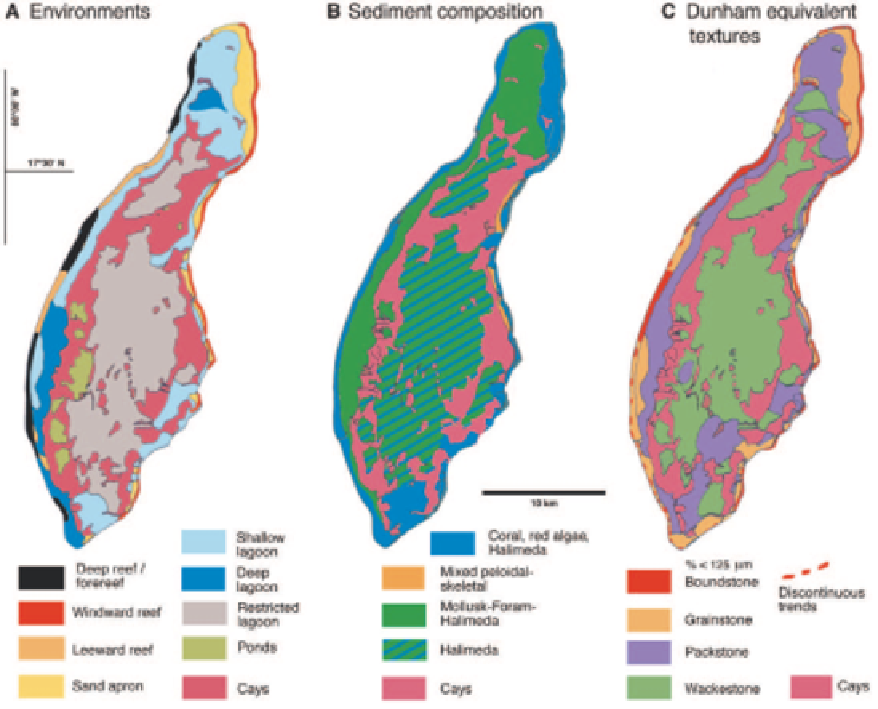Geology Reference
In-Depth Information
An example of a smaller isolated platform in the Car-
ibbean is shown in Fig. 14.5.
The study is based on the thin-section investigation
of the grain composition, grain size, and texture of plas-
tic-impregnated sieve samples.
A well-known example of an isolated platform is
the Great Bahama Bank (see Pl. 3). Controls on facies
distribution are the windward or leeward orientation,
open or protected water circulation, or tide- or storm-
dominated conditions.
Fig. 14.5
.
Facies distribution on an isolated carbonate platform.
Turneffe Islands, Belize, Central America. Turneffe Islands
are surrounded by deep waters. The distribution of the sedimentary facies is controlled by antecedent topography and exposure
to waves and currents. The maps show the relationships between environment, facies types and carbonate texture.
A:
Environments.
The platform has an almost continuous surface-breaking
reef rim
at the windward side. The reef margin is
characterized by a cemented coral rubble pavement transected by tidal passes and channels. Windward and leeward
forereef
areas dip toward the open ocean.
Sand aprons
are developed in water depths down to 2 m. The bottom of shallow lagoons and
deep lagoons (> 5 m) consists of unconsolidated sediment and is either barren or covered with sea grass and udoteacean green
algae. Restricted lagoons with depths of 8 m and 3 m are enclosed by mangrove swamps and islands. The bottom of the
lagoons is covered by sea grass,
Halimeda
and sponges. Subtidal ponds are located within mangrove rims. The cays/islands
consist of sand and mangroves.
B:
Facies types
expressed by the composition of the sediment. The coral-red algae-
Halimeda
facies is most abundant in the
marginal platform areas as well as in platform interior patch reefs. The
mixed peloidal/skeletal facies
is characterized by the
abundance of non-skeletal grains (predominantly peloids of fecal origin). The mollusk-foraminifera-
Halimeda
facies is common
in platform interior environments. It is characterized by high concentrations of bivalve shells, miliolids and algal fragments.
The sediments of the
Halimeda
facies contain more than 50% algal fragments. It is confined to the restricted lagoons.
C:
The texture of the surface sediments (using a modified Dunham classification) reflects the hydrodynamic conditions. The
distribution of the texture types is similar to the distribution of facies types in ancient isolated reefal platforms.
Boundstones
characterize the windward reef rim.
Grainstone
textures are abundant in the reef and forereef environments of the coral-red
algae-
Halimeda
facies.
Packstones
are most common in this facies in the sand apron, shallow lagoon, and patch reef
environments, and occur in the mollusk-foraminifera-
Halimeda
facies. The mixed peloidal-skeletal facies is characterized
by
wackestone and packstone textures.
After Gischler and Lomando (1999).


